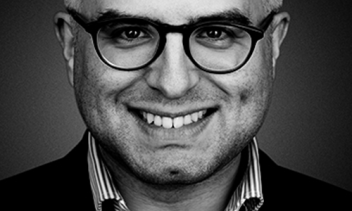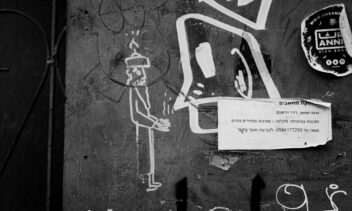In a world increasingly in flux, as the landscape of religious life constantly changes, so does the landscape of those that choose to leave religious life. The communal conversation today around those that choose to leave is increasingly self-aware, and the modes and mediums in which these conversations happen often reflect the cultural moment they occupy.
This month, 18Forty is thinking about those that leave religious life and the issues that narrate that decision. In preparation for this month’s topic, here are the two things you need to know.
1. A Brief History of Jews Leaving Religion
The world and religious community of today is far different from the world of Elisha ben Avuya, and even that of Baruch Spinoza (1632-1677). To appreciate what departure from observance means today, we must consider what it meant throughout history.
70 CE: Elisha ben Avuya: First of the heretics, this Tanna is said to have entered the pardes, the garden-paradise, and he was impugned when he “cut the saplings,” which may be an allusion to having heretical thoughts about dualism — the existence of a power equal to God. Elisha ben Avuya becomes known as Acher, the other one, and publicly broke with the commandments. In many ways the forerunner and patron saint of the once-Orthodox, Elisha remains an important test case for the Talmud’s dealing with the issue of departure from the community.
Medieval Era: Conversos: Jews who converted to Catholicism, largely due to threats on their life or livelihood, are known as conversos. Many found ways to practice their religion in private, and are referred to as marranos or crypto-Jews, while others adopted their new religion wholeheartedly. While not often a part of this conversation, considering conversos can inform our understanding of the ways medieval Jews expressed Jewish identity, even in the absence of formal Jewish religious life.
17th Century: Baruch Spinoza (1632-1677): Born in Amsterdam to a Sephardic family of once-marranos, or crypto-Jews, Spinoza became one of the greatest rationalist philosophers of his time. The Talmud Torah, which was the united congregation of Portugese Jews in Amsterdam, penned a scathing writ of excommunication against the young Spinoza, then 23. While we can’t be sure which of his views his critics knew at the time, in his later writings, Spinoza argued for a pantheistic God (“God or nature”), critiqued the conception of Jewish chosenness, and was an early voice in biblical criticism. His legacy as a philosopher of note is significant, as his ideas have led to centuries of considered debate. He remains one of the highest-profile individuals to leave the religious community, and the nature of his forced departure continues to inspire reflection.
18th-19th Centuries: Haskalah: A Jewish enlightenment movement, the Haskalah emerged in the more open religious environment of Germany and spread to Eastern Europe. The movement sought to bring Jewish life and ideas ‘out of the ghetto,’ in the form of social and cultural reform. Many religious Jews were attracted to the intellectual vigor and openness of the Maskilim, and the movement grew in popularity. In contending with the Haskalah, the Jewish community was forced to consider the many people who chose to change their observance of religious life, and that dynamic birthed much of the attitudes and dynamics of Jewish life today.
20th Century: “Kids at Risk”: In the later years of the 20th century, a now-stable American Jewish community had grown more aware of their successes, as well as their failures, and had grown reflective on the growing phenomenon of the ‘at-risk.’ A catchall for children with behavioral issues, addictions, religious/theological questions, and a host of other undesirable behavior, this phenomenon brought the issue of departure from the community to the forefront of the public dialogue.
2000s: The OTD Blogosphere: In the relatively early days of the internet, people who were struggling with religious life found a powerfully open forum for discussing the issues that were once considered secretly. With names like Unpious, Undercover Kofer, The Skepticher Rebbe, and Shilton HaSechel, these blogs offered community and conversation in what is still a fundamentally lonely journey. Although most of these blogs are no longer updated, as the conversation has shifted to social media, they were open, painful, passionate, and had an important role in bringing this conversation to a high-profile part of contemporary Jewish life.
2010s: The Era of the OTD Memoir: Following the proliferation of OTD blogs, reflections on the challenges and opportunities of leaving religious life were given a powerful platform in the popularity of the new genre: the OTD memoir. These brought this conversation from niche blogs to the national stage, and attracted attention from a wide array of readers. For readers from all backgrounds, these books provide a viewpoint into the complicated emotional landscape of leaving religious communities, and brought this discourse to an entirely new level of national exposure.
2020s: Visual Culture, Activism, and OTD Cinema: The once-Orthodox, now an established presence in the broader American Jewish conversation, meets the growing interest in the ultra-Orthodox community, and portrayals of the decision to leave come to visual media. The once-Orthodox also become a powerful voice for change, fighting for reform and change in a community once — and perhaps still — their own.
2. OTDictionary: Important Terms
OTD? Kids at risk? Kofer? Heretic? Apikores? Orthoprax? Frankist? Sabbatean? Confused about the plenitude of terms describing those with a plenitude of questions? Religious terminology is important, especially in a complex issue like this, and we’re here to help. For the first time, the authoritative dictionary on religious departure.
OTD: A hotly contested and controversial term, OTD stands for Off-The-Derech, and this term remains the most popular term, despite intense opposition to it. For many, this term represents a binary false to religious life: either on the path, or off it. But for others, this term remains the imperfect catchall description of a complicated phenomenon.
Kids at Risk: An early catchall term for this phenomenon, once-popular among educators and parents, this can refer to youth with a wide variety of behavioral, emotional, and religious struggles. This term highlights the vulnerability of those on the fence of departure, but not those that already left.
Chozer B’Sheilah: Return to questioning. Popular in Israel, this term is a clever wordplay on chozer b’teshuvah, one that returns to the faith, and is more understanding of the complexities of the lived religious experience. This term recasts the decision to leave as one of essential religious movement, as each question signifies an engagement with movement in religious life, no matter the direction.
XO: Short for ex-Orthodox, this term is playful and pithy, and it earns our respect for that. While not the most popular term, it remains the most fashionable of terms in this brief dictionary.
Kofer: Perhaps the most loaded term, this rabbinic label for heretic has a long and storied history in Jewish literature. Usage of this term is all about expression. Said with a sardonic smile, this term can be used endearingly, perhaps after hearing a slightly provocative dvar Torah at a Shabbos table. However, more often than not, calling someone a heretic may not go over well, which one should keep in mind next time they have an urge to shout it urgently in a debate.
Orthoprax: Correctness or orthodoxy of action or practice. [Contrast with: Orthodox: sound or correct in opinion or doctrine.] For those that struggle with religious belief or doctrine but appreciate a religious community or lifestyle, orthopraxy offers a way of life without a way of beliefs. Solution or symptom, this term has triggered significant discussion on the boundaries between belief and action in religious Judaism.
Tune in to our introductory podcast for OTD.








